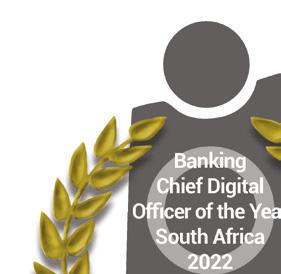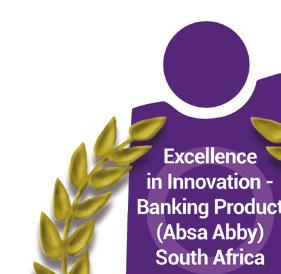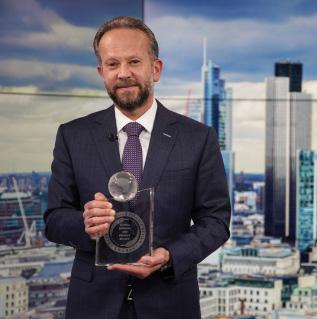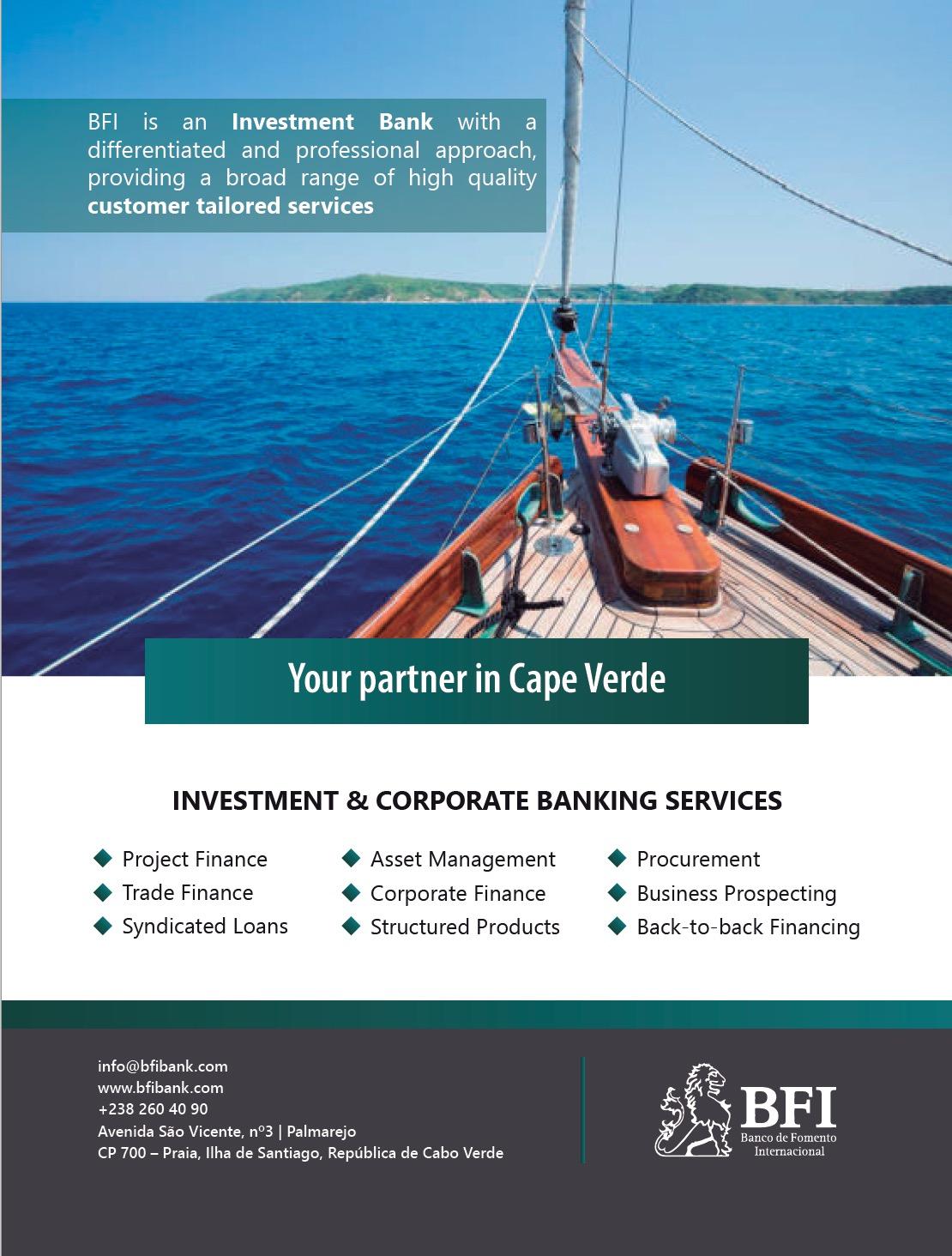

www.globalbankingandfinance.com Issue 44 and Sucor Asset Management Investor CEO On Consistent Collaboration, Returns Investing Indonesia’s
in Next Generation
Jemmy Paul Wawointana


Chairman and CEO
Varun Sash
Editor Wanda Rich email: wrich@gbafmag.com
Head of Distribution & Production
Robert Mathew
Project Managers
Megan Sash, Amanda Walker
Video Production and Journalist
Phil Fothergill
Graphic Designer
Jessica Weisman-Pitts
Client & Accounts Manager
Chanel Roberts
Business Consultants
Rick Saikia, Monika Umakanth, Stefy Abraham,
Business Analysts
Samuel Joseph, Dave D’Costa
Advertising Phone: +44 (0) 208 144 3511 marketing@gbafmag.com
GBAF Publications, LTD Alpha House 100 Borough High Street London, SE1 1LB United Kingdom
Global Banking & Finance Review is the trading name of GBAF Publications LTD Company Registration Number: 7403411
VAT Number: GB 112 5966 21 ISSN 2396-717X.
The information contained in this publication has been obtained from sources the publishers believe to be correct. The publisher wishes to stress that the information contained herein may be subject to varying international, federal, state and/or local laws or regulations.
The purchaser or reader of this publication assumes all responsibility for the use of these materials and information. However, the publisher assumes no responsibility for errors, omissions, or contrary interpretations of the subject matter contained herein no legal liability can be accepted for any errors. No part of this publication may be reproduced without the prior consent of the publisher

editor
Dear Readers’
Headquartered in Jakarta, Indonesia, PT Sucorinvest Asset Management is celebrating a quarter-century of operation, having grown its funds under management by 400% over the last 4 years alone. When I sat down with CEO Jemmy Paul Wawointana, he revealed that of all the organisation’s achievements over the years, he is most proud of its ability to grow together with its customers. Turn to page 24 to read my full interview with Sucor Asset Management CEO Jemmy Paul Wawointana on Investor Collaboration, Consistent Returns and Investing in Indonesia’s Next Generation.
In this edition we also take a look at how Apple’s changes to privacy have impacted advertising, find out what banks need to do to win over this generation, discover the top 5 digital transformation pitfalls, and much more.
We strive to capture the latest news about the world's economy, financial events, and banking game changers from prominent leaders in the industry and public viewpoints with an intention to serve a holistic outlook. We have gone that extra mile to ensure we give you the best from the world of finance.
Enjoy!
Wanda Rich Editor

FROM THE ®
Stay caught up on the latest news and trends taking place by signing up for our free email newsletter, reading us online at http://www.globalbankingandfinance.com/ and download our App for the latest digital magazine for free on Google Play and the Apple App Store
Issue 44 | 03 EDITORS LETTER
I am pleased to present Issue 44 of Global Banking & Finance Review. For those of you that are reading us for the first time, welcome.
BANKING
Why The Opportunity for U.S. Banks is a Lot Bigger Than “Not Failing,”
Marco Santos
CEO of USA and LATAM
GFT
Gen Z is Sparking a Banking Revolution: Here’s what banks need to do to win over this generation
David Donovan EVP of Financial Services
Publicis Sapient
FINTECH
Cloud Banking: How Cloud Computing is Transforming the Financial Services Industry
Trung Nguyen Hoang (Thomas Nguyen), Financial Services Solutions Group FPT Software
BUSINESS
Driving sustainable change: How the C-suite can boost the ESG agenda through procurement
Edward Cox Principal Efficio Consulting
How Have Apple’s Changes to Privacy Impacted Financial Service Orgs Advertising on Facebook and Instagram?
Scott Frey Original Founder
PossibleNOW
Lessons for the CFO: Managing finances and the workforce this winter
Hartmut Wagner CEO Serrala
Why good businesses shouldn’t fear recession
David Kean
International Best Selling Author
Suspicion as a business model has no fortune – trust is the new trend
Valentin Ivanov co-founder and fund manager Quanloop

04 | Issue 44 CONTENTS 48
28
40 10
14 34 44 48
46

Issue 44 | 05 CONTENTS 20 16 FINANCE Optimizing KYC processes to prevent money laundering Chor Teh Director, Financial Crime Compliance Industry Practice Lead Moody's Analytics It’s nothing personal: How financial services are missing the mark on bespoke outreach James Breeze Principal Consultant Credera UK Criminal Minds: Account Opening Fraud Tactics put to the Test Raj Dasgupta Director, Global Advisory BioCatch 18 38 12 TECHNOLOGY Michel Roig explores the trends accelerating biometric payment card adoption Michel Roig President of Payment & Access Fingerprint Cards Top 5 digital transformation pitfalls Richard Farrell Chief Innovation Officer Netcall How Financial Services Providers Can Use Cloud to Drive Innovation Rob Kim CTO Presidio 20 32
Jemmy Paul Wawointana CEO


Sucor Asset Management CEO on Investor Collaboration, Consistent Returns and Investing in Indonesia’s Next Generation
PT Sucorinvest Asset Management 06 | Issue 44 CONTENTS COVER STORY QNB FINANSBANK DIGITAL BRIDGE Okay Yıldırım CEO & Head of Group Corporate Digital Banking QNB eFINANS 08 24









Financial Services Provider Registered Credit Provider
When it comes to Digital Banking, we are the best in class. We won big at the Global Banking and Finance Awards 2022 • Best Digital Bank South Africa 2022 • Excellence in Innovation Banking Product 2022 • Banking Chief Digital Officer of the Year 2022 That’s Africanacity.
Authorised
Reg No NCRCP7.
QNB FINANSBANK DIGITAL BRIDGE
QNB Finansbank Digital Bridge was launched in September 2019 to bring the way companies do business into the future, to stand by them in the digital transformation process and to ensure that they are ready for the digital future in terms of technology. Since 2019, Digital Bridge has been designed as a platform where companies can meet both their banking and non-banking needs digitally, facilitating operational and daily transactions by periodically analyzing the needs of companies in this process in order to prepare them for digital transformation.
Digital Bridge, which makes it easier for companies to reach their periodic and long-term business goals with digital solutions and migrates their operations to the digital environment, serves its customers with 14 different solutions from 12 fintech experts in their fields as of 2022. Digital Bridge Platform offers solutions under 4 main categories, namely e-Commerce, e-Transformation, Management, and Financial Solutions, and can be accessed with the password used to log in to QNB Finansbank digital banking channels without the need for an additional password. It provides customers with great time and operational efficiency, thanks to the ability to monitor all their business on a single screen at once and the integrated working model of the solutions.
Digital Bridge, which has its own Call Center in order to respond instantly to technical and after-sales questions of its customers, also provides postapplication support 24/7.
In addition, Digital Bridge has launched the Digital Bridge Academy, a training platform where customers can learn how to use the solutions on the platform, follow the trends in the sector and get information on the subjects they are curious about with respect to their company through the Digital Bridge Academy Blog.

Besides, Digital Bridge has been positioned as the gateway of QNB Finansbank Corporate Internet Branch and QNB Mobile for all QNB Finansbank corporate customers.
Okay Yıldırım, CEO of QNB eFINANS & Head of Group Corporate Digital Banking stated that; “Through these innovations, Digital Bridge Platform has offered digital solutions that companies can easily meet banking and non-banking needs such as e-commerce, finance and managerial needs with one password on a single platform. As the first “bankingas-a-platform” in Turkey and such a unique example in the world, Digital Bridge won 8 international and prestigious awards since 2021 and has proven its success both local and international levels. Digitally speaking, our platform is seen as a living environment and developing itself continuously. We continue to extend this environment by adding new and beneficial solutions to carry companies one step ahead.”
The efforts to reach and view corporate banking transactions under Digital Bridge roof were further reinforced with the introduction of "QNB Finansbank Agenda" widget on Digital Bridge Platform in November 2021. Thus, companies are able to instantly access the reminders associated with their banking transactions. They are able to make their payments without a delay by viewing them in the "QNB Finansbank Agenda" widget through reminders for 32 important payment & collection products transactions.
Through Digital Bridge, QNB Finansbank continues to be Turkey's first and only bank that provides an extensive range of digital solutions to meet all the needs of companies and offers them under a single platform (Digital Bridge Platform) with favorable packages.
As all these developments show, the Digital Bridge Platform has gained a new dimension and started to hold a significant place for its customers in only 3 years. With the inclusion of QNB Finansbank's digital banking channels into Digital Bridge, the platform has become the only gateway for customers' banking and non-banking transactions and the sole brand in QNB Finansbank for the corporate segment, thus bringing the customers' experience to the next level. Currently, approximately 100 thousand companies use Digital Bridge, and approximately 300 thousand customers using the corporate digital banking channels access these channels via Digital Bridge. No other services offer companies such a privileged experience.

Moreover, QNB Finansbank Digital Bridge won six international awards in 2021 and 2 international awards in 2022 as a pioneer of "Platform Banking" in Turkey. It has proven its success at an international level with the awards it won in the fields of outstanding innovation, digital strategy, technology, digital transformation, and online services. Digital Bridge is easily and freely accessible to all corporate segment clients, especially SMEs, and will maintain its digitalization efforts unceasingly in 2022.
 Okay Yıldırım
Okay Yıldırım
CEO & Head of Group Corporate Digital Banking QNB eFINANS
Driving sustainable change: How the C-suite can boost the ESG agenda through procurement
Whether you’re a passionate supporter of driving sustainability improvement or a sceptical follower, chances are you’ve been drawn more deeply into the sustainability debate over the past year or two. But now is the time to act … and deliver.
Today, companies across the globe are struggling to make progress in the race to net-zero, with many organisations falling behind on setting climate transition plans.
And it’s no wonder – the move towards more sustainable practices is firmly on the C-suite agenda, but the journey isn’t an easy one. Other priorities, such as saving costs and ensuring business continuity during turbulence, often take precedence on boardroom agendas, pushing ESG issues lower on the priority list.
However, the cost of ignoring the sustainability agenda is significant.
There’s a growing recognition that procurement can play a key role in driving actionable change, thanks to third-party spend accounting for a significant percentage of revenue. This opens great potential when it comes to reducing both environmental and social impact. Procurement’s prime position to be a lever for sustainable change can be maximised by following our 10 steps to sustainable procurement, based on ESG work we’ve done both internally and with our clients.
Step 1: Understand organisational objectives
Driving any sort of actionable change begins with setting and understanding organisational objectives. Many organisations fall into the trap of wanting to improve everything all at once, but this simply isn’t realistic. Understanding what is truly important to your organisation and where you can help needs to be the very first step.
Step 2: Engage sustainability leads
If your organisation has a sustainability function, then it should be setting the business-level strategy from which the procurement team derives its own strategy. This sustainability function should also act as the Subject Matter Experts (SMEs) to guide around policy, sustainability approaches, and requirements.
Step 3: Baseline your approach and capability
As the agents of change, your team needs to be equipped with the right targets, skills, and tools, so make an honest assessment of your current capability. Does the team understand the sustainability agenda and how it can play a part? Is sustainability built into the fabric of the procurement process, especially in category strategies?
Step
4: Triage your spend categories
A key step is to triage spend against agreed sustainability themes to understand which spend areas can drive which themes. These areas should be weighted by spend, sustainability opportunity, and ability to impact.
Step 5: Improve your
sourcing approach
Sustainable procurement does not require a new skill set, but it does require a new mindset. Companies must train and encourage their teams to think in terms of cost, service, and ESG and, as such, to adapt sourcing methodologies to reflect this additional parameter. Implementing new tender questions (refined by theme or capital), new scoring and evaluation approaches, as well as effective signoff governance will ensure ESG is effectively considered and does not become a box to be ticked.
Step 6: Implement a SRM (Supplier Relationship Management) approach Sustainability requires collaboration, and this means ensuring suppliers align on approaches. Business strategies should be underpinned with macro goals shared by the many, distilled into multiple and sustained changes to behaviour. In turn, this should mirror a more collaborative approach that seeks to deliver long-term value through better engagement with supplier partners. A fair and well-communicated roadmap is essential to success.
Step 7: Invest in training
Whilst there will be motivation in procurement teams to drive change, it is all too easy to revert to previous behaviours when the next cost target lands or performance reviews come and they do not evaluate ESG value delivery. Training is key to embed change. Start with the basics and move towards a specific toolkit.
10 | Issue 44 BUSINESS
Step 8: Establish clear Key Performance Indicators (KPIs)
Currently, sustainability improvements are being hindered by an inherent lack of accurate data. Without it, organisations find it hard to make decisions as they lack the objective insight – and they then fail to get the feedback loop that informs them of the impact of their decision making. Each sustainability theme should have a measure and target while the data improves – even if they are crude at first. If you can convert the KPI into a currency measure (£/$,€ … ), even better.
Step 9: Build a playbook
Each of these steps should be encapsulated into a playbook that can act as a guide and governance to procurement teams – laying out what Procurement will do, how it will do it, and whom it will engage with to maximise outcomes. The sustainability landscape is developing quickly, and we all need to absorb best practice as we find them.
Step 10: Communicate your policy
Sustainability-related issues present a key opportunity for Procurement to rebrand itself as more than a business function for delivering cost optimisation, and instead one that can be a meaningful driver of the sustainability agenda – one of total value, rather than total cost.
Alongside board-level commitment, procurement is the key catalyst for organisations to successfully drive measurable sustainability improvement and achieve their ESG objectives, as they can select and nurture relationships, partnerships, and strategies that best promote their company agenda.


 Edward Cox Principal Efficio Consulting
Edward Cox Principal Efficio Consulting
Issue 44 | 11 BUSINESS
Michel Roig explores the trends accelerating biometric payment card adoption

The growth of contactless biometric payment cards has gained even more momentum in 2022. With recent launches in Morocco , and more on the horizon, it is an exciting time for the technology. But what external factors are driving this trend and why should the payments industry take note?
Mandates and mobiles
Changes in payment technology have seen cards overtake cash as the most popular method for in-store purchases. According to Fingerprints’ research, cards account for 73% of instore payments globally, with 50% of these being contactless. However, when it comes to protecting in-store payments, there is a growing gap between security and convenience with the rise of contactless.
This contrasts with digital payments, where we’ve seen a global trend of evolving banking regulations to support innovation and security. For example, Strong Customer Authentication (SCA), a requirement of the Second Payments Services Directive (PSD2), has come into play in Europe.
This evolving security ecosystem around digital payments has spiked interest in biometric payment cards. With SCA, customers need two of the three forms of authentication to make an online purchase (something they know such as a password; have such as a card or phone; or are such as a fingerprint). Biometric payment cards offer this level of authentication too, so it makes sense to harmonize the security between online and in-store payments with biometrics.
Having become a de-facto authentication method for accessing and unlocking smartphones, the role of biometrics in mobiles has evolved significantly to support SCA-compliant payments and, increasingly, knowyour-customer and ID verification. But, the use of smartphones to make instore purchases is also growing, and there are set to be 4.4 billion digital wallet users by 2025 . But not everyone wants to, or can use, a mobile wallet and consumers will always use contactless cards as a backup in an increasingly cashless society.
Biometrics offers synergy for contactless in-store payments. Consumers should expect the same level of security in all the devices they use, whether a mobile phone or payment card. The mobile industry set the standard, integrating biometrics into the payment experience offering SCA with every transaction. It is up to banks to demand this innovation for cards, since consumers are expecting it and also the same level of SCA can be included in their cardbased offerings. Card issuers should be implementing the innovative and secure feature as part of their standard offering.
Lingering worries about contactless fraud
For in-store contactless card payments, SCA requirements are met through a chip-and-PIN input when reaching spending limits. But does this adequately respond to consumer needs? Our research shows that significant concerns exist around contactless payment security.

Although 77% of consumers use contactless regularly, half are worried about the lack of security if their card is lost or stolen and around a quarter are confused about spending limits. One example of where these concerns have materialized is in the UK , which in October 2021 increased its contactless payment limit from £45 to £100 – making it the highest in Europe.
To help prevent contactless cards from becoming a ‘ thief’s dream ’, some banks allowed consumers to control limits. Some consumers were only too willing to do this. According to Lloyds Bank , more than 800,000 customers have set alternative limits (with 60% opting for a cap of less than £50) or deactivated contactless entirely. Increasing limits without considering appropriate security mechanisms run the risk of card technology regressing.
With biometric payment cards, consumers can experience both security and convenience for instore contactless transactions as only the authorized user can make purchases, while also benefiting from no spending cap.
A blossoming Fintech ecosystem
Banks have traditionally dominated the financial services industry, yet the digital revolution and increasing cashless opportunities have allowed a new type of challenger to enter the market – financial technology companies, or fintechs.
12 | Issue 44 TECHNOLOGY
Michel Roig President of Payment & Access Fingerprint Cards
The fintech business model that underpins customer attractiveness relies heavily on differentiating from banks through offering value-added services, such as metal or ecofriendly cards. This means that the fintech ecosystem often sits at the forefront of innovation. The focus among fintechs to offer next-gen customer experiences means that biometric payment cards present a big opportunity.

Our research has found that 51% of consumers are willing to switch banks to receive a biometric payment card, and 43% are willing to pay to receive one. This customer acquisition opportunity is one some fintechs have already identified and leveraged . By offering consumers a seamless and secure contactless user experience that isn’t currently widely available at traditional banks, fintechs will become an attractive prospect for consumers. We expect the fintech trend to continue growing and with it to announce further fintech partnerships in the coming year.

Keep an eye on DeFi
And it’s not only ‘traditional’ finance that is benefitting.
Cryptocurrencies have experienced a tremendous spike in popularity in recent years, with an estimated 106 million people worldwide using crypto exchanges today. Typically, those who use cryptocurrencies do so for high volume and value transactions, with the average Bitcoin transaction value being US$25,000 as of 2020
Much like any financial technology, security is essential. Currently, the main way to store, access and manage crypto (exchanges, hot and cold wallets), is with a private key. But what happens if a user forgets their private key, or worse, it becomes compromised?
Introducing biometric authentication to help us store and access cryptocurrency makes sense. It can provide an additional layer of

security to cryptocurrency storage and authentication, and progress is already being made in this space, championed by some of the tech industry’s most recognizable names
An exciting time for biometrics
With the clear need for security that does not compromise convenience, the desire among consumers for the technology, and the readiness of the technology for mass rollout, the coming years look exciting for biometrics. With biometric payment cards, issuers can deliver for their customers a truly unified, smarter payment experience, unlocking the same level of security without sacrificing convenience.
Learn more about the global potential of biometric payment cards by downloading our eBook: ‘ Making Contactless Payments Worryless ’ and find the answers to common questions about biometric payment card launches in our FAQ
Issue 44 | 13 TECHNOLOGY
How Have Apple’s Changes to Privacy Impacted Financial Service Orgs Advertising on Facebook and Instagram?
Direct-to-consumer financial service organizations that previously relied heavily on Facebook as a way to target and advertise on the social media giant are now starting to realize the perils that resulted from privacy policy changes instituted by Apple. These changes have upended the digital advertising strategy for hundreds of thousands of financial service organizations and have forced these companies to find a new path to their coveted customers.
Some financial service brands have remained loyal to Facebook and also Instagram, but many others are making sharp pivots to embrace more zero-party data and first-party data while leveraging new social platforms for marketing based on one-to-one connections, such as TikTok.

What changed with Apple?
Apple, maker of the iPhone and iPad, has made changes to the way it handles privacy for its users. Specifically, they now give customers enhanced control over privacy settings that empower them to have more say over which of their personal data is provided to brands.
Driven by Big Data, these ads have helped financial service organizations target people on social platforms such as Facebook and Instagram, who in the past had the ability to deliver messages to someone who possesses the characteristics that indicate the messages and offers are likely to be of interest.
Of course, Big Data is the process of purchasing data from a third-party provider, collecting online activity, purchase history, social media content and more to identify people that are potentially interested in what financial service organizations have to offer – all driven by social companies like Facebook and Instagram.
How are financial service brands of every size changing their marketing? But today Apple’s privacy changes have made this process more difficult, driving more financial service organizations to seek alternate channels for delivering their marketing messages. Aside from privacy, this pivot isn’t all bad news for financial service organizations since these Big Data-driven ads were based on outdated or inaccurate data.
As a result, a growing cadre of financial service brands are taking a more community-driven approach to building relationships and producing their own content on social platforms and blogs, while also working with smaller-scale influencers and returning to other “traditional” forms
of marketing such as direct mail and email. These brands feel that engaging more with consumers on social media through direct messages is almost the opposite of the largescale targeting of consumers they had previously employed via thirdparty lists. By taking a more oneon-one approach to each individual customer, they can make a more lasting impression.
This pivot has helped financial service organizations leverage zeroparty data, which is information a customer freely and intentionally shares with a brand they trust. It can include personal insights like preferences , feedback, profile information, interests, consent, and purchase intent.
14 | Issue 44 BUSINESS
The Result is More Trust, Empowerment & Data Control
This step is in the right direction in that customers should be more in control of their data. The benefit of using zero-party data is that:

• it is unique to the brand and no other brand has the same data;
• it’s the ultimate source of truth in that the customer offers up their own insight, rather than making assumptions based on big data and;
• it is relationship-based so it relies on a higher level of trust with the customer which means the company must be transparent about their use of the data and the relationship must be mutually beneficial.
Every communication across the customer life cycle (e.g., prospect, purchase, registration, customer service) creates a wealth of potential regarding the collection of zero-party data. For example, you can send customers a survey to better understand their unique perspectives on the company, products or services. There are also opportunities to build a quiz into your welcome email, which can be both engaging and insightful. You can also send a text message shortly after a customer makes a purchase and be a little creative to entice consumers to share data and to set yourself apart from others. Many companies today are also leveraging pop-ups on their website that asks a few engaging questions, with the promise of providing something of value in return for their time.
Even B2B-focused financial service organizations are seeing changes to the way in which they’ve been leveraging marketing. The FTC is currently reviewing whether to continue its Telemarketing Sales Rule business-to-business exception, which if discontinued means B2B-focused financial service organizations would no longer be able to leverage telemarketing as the government cracks down on telemarketing abuse. This change would mean B2B financial service organizations would also need to identify new ways of marketing, such as zero-party data approaches.
With the changes implemented by Apple, Facebook and Instagram have become less appealing as marketing channels. This has made the focus of zero-party data and new social platforms and engagement through blogs and traditional marketing even more valuable. Financial service brands that head in this direction and embrace new opportunities for marketing and consumer engagement will see great benefits in the years ahead.

Scott Frey
Original Founder
PossibleNOW
Scott Frey is the original founder of PossibleNOW formed in 2000. Today, he serves as the President and CEO for PossibleNOW, Inc. and PossibleNOW’s wholly-owned subsidiary, CompliancePoint. Frey is responsible for the business growth and acquisition strategy, product development initiatives, and all sales and marketing strategy for both companies. He specializes in designing technology and professional services solutions to solve complex business challenges related to marketing and compliance operations.
Under Frey’s tenure as CEO, the company has evolved from a marketing compliance solution provider solving privacy and compliance issues, to a more diverse organization that helps companies leverage PossibleNOW’s Zero-Party Data solutions to deliver relevant, targeted, personalized communications to their customers and prospects, increasing profitability and customer loyalty.

Issue 44 | 15 BUSINESS
Optimizing KYC processes to prevent money laundering

Despite the continual development of solutions to combat money laundering, criminals still have the capacity to get ahead. Indeed, it is hard to escape news stories of money laundering activity in the media. Presently, anti-money laundering (AML) measures can demand huge amounts of time, capital, and vital resources from organizations. And still criminals find ways around systems and processes.
With a growing complexity in global supply chains and counterparty relationships, money laundering and the exploitation of financial services are global issues for regulators, corporates, and compliance professionals alike. Optimizing KYC processes however can be an invaluable tool for organizations when it comes to preventing bad actors using them to legitimize dirty money or hide human rights violations.
Digital economy grows; crime grows
New and advanced techniques are constantly emerging to exploit lawful individuals and organizations. These criminal activities have arisen in part due to a rapid expansion of the digital economy - the explosion of fintechs and Neobanks has offered new methods for money laundering.
Preventing money laundering has also become more challenging as the digital economy is a borderless economy. Organized crime groups engage in cross border activity, to take advantage of regulatory blind spots and to insert illegal operations into supply chains. Consequently, regulators, financial services businesses, and compliance teams are finding themselves playing catch up, rather than besting criminals.
16 | Issue 44 FINANCE
With all that said, for criminals to legitimize their money and circulate it back into the mainstream financial system is not easy, and it’s where they have vulnerabilities.
Organizations can and do prevent money laundering daily through AML compliance, risk management processes, and enforcement of rigorous KYC. Regulatory technology is one method that has improved these procedures.
Also, regulators, law enforcement, and financial institutions are uniting resources in support of legislation such the German Supply Chain Due Diligence Act. And they are sharing information to create more corporate transparency, which helps uncover counterparty risk. Implemented effectively, organizations can use data and automation as the foundation for a robust KYC framework.
Leaning on KYC
Automating KYC processes has numerous advantages, not least, it improves the efficiency of the KYC processes themselves. Automated risk-engines can process the intensive workloads involved in continually monitoring risk and carrying out routine checks. This makes them ideal for executing AML processes to uncover politically exposed persons (PEPs) and sanctioned individuals for example.
Automating KYC and introducing AI can also be integral to identifying recurring patterns which might point towards criminal activity. Automation is adept at spotting these recurring patterns and raising flags for investigation into possible money laundering threats.
However, automation will only get a firm so far. Risk is continually changing and evolving, and recognizing new threats is something automation alone cannot tackle. Professional insight is invaluable here – a person carrying out the ‘sniff test’ and detecting that something simply doesn’t feel right.
Chor Teh
Director, Financial Crime Compliance Industry Practice Lead Moody's Analytics


AI models are not yet able to accurately predict and identify new behaviors, meaning human involvement is crucial for spotting new risks and new forms of criminal activity. Human influence and effective technology working together is the most powerful and effective combination in the fight against financial crime.
Hitting the right balance
Although automated technology is excellent at developing efficient KYC processes, it is not complete enough to operate independently and understand the full nuance of criminal threat. It is paramount that financial institutions truly understand their customers and counterparties to properly control risk.
Finding the balance between automation, technology, and cognitive thinking is the most effective strategy for optimizing KYC processes. It enables humans to identify the complexity and variation in crime while ensuring the most informed risk-based decisions are being made on behalf of a business.
Issue 44 | 17 FINANCE
financial services
While sectors across the board race to perfect their personalised customer outreach, the same journey in financial services seems to lag. Despite being rich in data, funding and technologies, personalisation can often seem low on the list of priorities. So why does the financial services industry have so much catching up to do – and how can it get on the front foot?
James Breeze, Principal Consultant for Credera UK , explains.
On paper, FS is an obvious industry to utilise customer data cleverly. It certainly has enough of it. Think of your bank, your mortgage provider, your car insurer. They know a lot about you – how much you’re spending, how regularly, and whether your income and outgoings match up.
We know that effective personalisation drives customer satisfaction, customer loyalty and upsell of additional services. So why aren’t banks and building societies making the most of it?
There are four key reasons that the finance industry finds it difficult to lead the charge when it comes to personalised customer outreach:
Risk aversion
Banks spend all day, every day dealing with peoples’ livelihoods and welfare. Handling someone’s cash is important. Throwing data around in an industry like finance could have significant ramifications – and as a result, the power and control that risk aversion has over a financial services business is a real brake on progressive customer outreach.
The dial is turned towards aversion and therefore little regard is paid to the potential. That’s understandable, but also a missed opportunity.
Working in silos
Financial services tend to be structured by channels and by products – a home insurance team, a car insurance team, a mortgage team, a personal savings team… these categories don’t necessarily and operationally make sense together. And so, when two teams (or 200 teams) under the same roof are working separately, it becomes difficult to stitch knowledge and processes together seamlessly.
You might be one consumer whose engagement spans several different products or departments, but something as seemingly insignificant as a space in a postcode or the inclusion of a middle initial can cast doubt on that fact. Yet that’s not an easy problem to fix, as merging records would have enormous data privacy and regulation impacts.
Traditionalism
There is a perception that many people rely on the reassurance of an ‘in-person’ experience for their banking, where they might not in other areas of their lives.
While the general assumption is that ‘older’ customers are wary of digital services, it’s an assumption we must start to challenge more and more. In five years, 50-year-olds will have had an email address since their
teens. Plenty of people in their 80s have smartphones – in fact, 66% of the entire global population do. Our expectation of digital uptake and customer communication needs to evolve as quickly as its users.
Regardless of your personal stance on digital versus physical nowadays, it’s undeniable that banking traditionally relied on in-person interaction. That may have started to change years ago, but that original position caused a lag in organisations always having the right data, in the right place and at the right time.
Infrastructure
Due to the nature of the highly specialised individual products offered by banks, very bespoke IT infrastructure follows suit. This tends to silo departments and accentuate tech issues. The systems are expensive to maintain, but even more expensive to modernise.
It’s easy to see how banking has fallen behind when it comes to matters of tailored outreach – but there’s a huge opportunity for these organisations to enhance their offering by focusing on their data and how it’s used.
So how and why should financial institutions focus on data-driven personalisation?
It’s worth noting that banking traditionally scores quite low in consumer trust polls. The stakes are high – it’s people’s money, it’s important and most consumers are inherently a little guarded – so trust between an individual and their FS
18 | Issue 44 FINANCE
It’s nothing personal: How
are missing the mark on bespoke outreach
provider doesn’t come naturally. A good personalisation strategy is therefore one that builds that trust. That might be a journey which starts with a softer approach: “We’re using your data for this purpose – is that okay?”

As you strengthen trust with your customer, you can start to think about demonstrating a fair value exchange – use of their data offers a seamless customer experience, and their necessary interactions with their provider don’t have to be such a burden as a result. Enhanced use of data to personalise services can, in time, create a symbiotic relationship of mutual benefit to financial services providers and consumers.
There’s a whole swathe of benefits that can be derived from getting it right. Having a fabulous end-to-end customer journey is brilliant for retention. For a large organisation with multiple strings to its bow, the ideal customer is one that has several products with that one institution, but that switches between transactions with them seamlessly.
Relevancy and timeliness don’t just help with existing customer retention, but with cross-selling, too. Knowing someone took out a mortgage a year ago and therefore may need to renew their house insurance might sound simple enough, but it can have an impactful result. People crave convenience, and tailored content can help with that.
Of course, financial services must continue to walk the tightrope of regulation – the industry is risk averse for good reason. But within those rules if you can present five relevant options, rather than 500 available products, based on what you know about the customer and their spending habits, you’re likely to continue to drive retention, customer satisfaction and additional sales.

The personal relationship between financial provider and consumer is an increasingly modern issue which requires increasingly modern solutions. Consumers in every demographic group are digitally-savvy, reliant on financial services and looking for ways to make their busy lives easier and more convenient. The opportunity to offer a holistic, data-driven solution to them is there for the taking, if only for providers who are brave enough to take the leap. There’s no need to start from scratch or go it alone – reaching out to expert advisers could help you navigate choppy waters. Putting your faith in your data could be the best thing you ever do for your customer relations.
Breeze Principal Consultant Credera UK
Issue 44 | 19 FINANCE
James
Top 5 digital transformation pitfalls
While 70% of organisations have already piloted automation technologies, many struggle to achieve the full potential of digital transformation, with less than 20% managing to scale across multiple parts of their operations.
Organisations often fall into the same common traps, so we have put together a list of the top pitfalls to avoid based on ours and our customers’ experiences.
Try to avoid these stumbling blocks for a faster, more seamless digital transformation journey.
1. Go big or go home mentality
Digital transformation is upending business and operational models. Facing this new reality, some leaders are trying to get ahead and dive full force into digitisation. This can lead to starting with overly complicated projects or prematurely implementing an automation across operations. Instead, organisations should start simple, then use that project as a case study for the rest of the organisation.
Kate Hurr, Senior Manager Digital and Customer Experience for Cumbria Country Council , said, “You just have to start somewhere and deliver something – it doesn't have to be right, it doesn't have to be perfect, it just has to be something that people can start to use”.
Some make the mistake of starting with a complex project to speed up their ROI and, while they can learn a lot, they can often find themselves encumbered in the sheer complexity
of the project. By starting smaller, organisations better facilitate their team’s education on new tools. This newfound knowledge can then be applied to more complicated projects moving forward.
Organisations also tend to falsely assume they need to acquire extensive technical expertise for significant change. However, as Kate from Cumbria Country Council said, “You don’t have to build a development team with the obvious technical people. We built our transformation journey on the back of really good business analysts, with some technical support and oversight”.
Amid talent and skills shortages, organisations can still embark on an effective and personalised digital transformation journey using a Lowcode Application Platform. An in-house development team can create software that connects systems and automates processes, that can be further enhanced with RPA and AI to unleash intelligent automation capabilities.

You can start small and build from there. Any organisation that embarks on this journey is going to make mistakes along the way, that is an unavoidable part of the learning process. The key is to learn from those mistakes as you move forward.
2. Lack of strategy
A strategy needs to be in place in advance for effective digital transformation. Without one, digitisation will likely lack focus and use resources inefficiently. Long-term goals along with shorter-term plans over a variety of time-scales should always be kept in mind.
Vicky Green, Digital Programme Manager at Ashfield District Council , said that starting without a blueprint led to a lot of confusion and a lack of direction. Having learned the importance of strategy on the digital transformation journey, the Council now works off a blueprint that considers where they want to be in three years and offers structure, purpose, and priorities.
Any strategy should be developed in consort with people across the organisation –especially those who will be using the newly implemented tools – because it is these people that will determine whether a solution is met with failure or success. Their feedback should be considered during planning and for determining what processes to automate.
By including colleagues in the building design process, substantial buy-in is cultivated and applications are tailored to what will most boost productivity and ease workloads.
This up-front work, ahead of any actual development or implementation, makes the eventual roll out of automations much smoother by helping prioritise what to automate first and avoiding the time and cost of reworking ineffective implementations.
It is key that organisations take the time to understand processes before they start automating them. As Anand Patel, Head of Technology & Innovation at Network Rail, said,
20 | Issue 44 TECHNOLOGY
“Sixty to 70% of the work is done before you start doing any coding whatsoever.”
3. Going it alone
Working with a partner or vendor can be an easy and cost-effective way to ensure digital transformation success and accelerate access to markets, talent, capabilities and technologies.

A committed partner with proven expertise and experience can help deliver impactful and tailored outcomes and achieve fast ROIs.
A partner with a robust low-code platform can enable your organisation to adopt a flexible approach that integrates well with your existing infrastructure and allows you to digitise at a pace that works for you. Such a platform can offer a range of advanced technologies like robotic process automation (RPA), artificial intelligence (AI) and machine learning (ML) capabilities, omnichannel communications, etc.
A suite of solutions and innovative partners allow organisations to create the automation roadmap that works best for them, maximising returns, better servicing customers or citizens, boosting productivity and relieving employees of excessive workloads.
4. Trying to put an ‘I’ in team
All too often, organisations take too long to realise the importance of bringing your entire team along for your digital transformation journey, from the beginning. Digital transformation is a collective effort, which makes communication across employees and stakeholders essential.

Issue 44 | 21 TECHNOLOGY
This coordination makes sure everyone is working towards the same goals, avoids repeated mistakes, encourages learning and builds a culture of innovation. It also saves costs by avoiding double work and automation chaos.
Low-code empowers more people from your organisation to participate in the development process. Business users can be trained to be low-code developers, unburdening IT teams and speeding up digital transformation efforts. Communication between teams results in the most effective automation journey. Rather than relegating all development to a siloed IT team, business and IT should share the entire lifecycle.
For Waverley Borough Council, using low-code and partnering with a provider that offered learning resources enabled them to utilise and upskill their existing talent and engage in timesaving collaboration. Linda Frame, the Council’s IT Manager, said that such a platform empowered their staff to use and create what they needed.
By unleashing collaboration across your organisation, under the governance of IT, faster and more effective results are delivered.

5. Risk aversion
We learn from our mistakes. The most successful organisations reward and embrace this mindset, realising that experimentation is a requisite for innovation and creativity. One review of teams at Google found that when employees felt they could take risks without shame or criticism for failure, they did better work.

This ethos fosters faster time to value because when workers are not worried about unattainable perfection, they iterate quicker and more often – and repeated iteration is the name of the game when it comes to digital transformation. Find your minimal viable product then start and improve from there.
“Don’t expect to be right the first time, iterate it. Because being right the first time costs you a lot of time. Instead, get feedback and incorporate realworld experience,” said Anand from Network Rail.
22 | Issue 44 TECHNOLOGY
Richard Farrell Chief Innovation Officer
Netcall

As digital acceleration creates an environment susceptible for identity fraud, how will you adapt? NICE Actimize IFM-X: The First Line of Defense Against Fraud CORPORATE IDENTITY THEFT: WHAT IT IS & HOW TO PREVENT IT Learn More info@niceactimize.com | niceactimize.com/blog | @NICE_actimize | /company/actimize | NICEactimize
Sucor Asset Management CEO on Investor Collaboration, Consistent Returns and Investing in Indonesia’s Next Generation
Headquartered in Jakarta, Indonesia, PT Sucorinvest Asset Management is celebrating a quarter-century of operation, having grown its funds under management by 400% over the last 4 years alone. It currently manages a number of award-wining mutual funds, and in 2021 received the Global Banking & Finance Review award for Best Asset Management Company - South East Asia.
When Wanda Rich, Editor of Global Banking & Finance Review, sat down with CEO Jemmy Paul Wawointana, he revealed that of all the organisation’s achievements over the years, he is most proud of its ability to grow together with its customers. “We’ve delivered consistent, positive returns and outperformed the benchmark throughout the past decade, which has led to significant growth in our asset under management (AUM) to IDR 38,39 Trillion Rupiah, per 30 September 2022, and more than 1.2 million investors, with retail investors contributing around 60% of our AUM,” he reported. “Our investor number has grown more than 400-fold since 6 years ago when we started to focus on strong brand awareness and customer loyalty, underpinned with the increase in Indonesia’s financial literacy and inclusivity in the digital era.”
This achievement is also supported by Sucorinvest’s collaboration with growing numbers of selling agents such as banks, securities companies and fintech companies, and the many annual domestic and international awards it has accumulated. “We have also seen a shift in our customer demographics, where currently 90% of our retail investors are of a younger age - below 40 - promising long and growing relationships,” he added.
Sucorinvest’s value proposition and investment strategy are supported by its vast experience and steadfast reputation in asset management. “We are highly committed to generating competitive returns for our funds to our valued investors, to deliver the best investment solutions that fit their needs and objectives,” Jemmy Paul said. “We believe in finding value in each business and market cycle for our alpha creation, which provides the best investment solutions for our customers’ needs.
“We apply an active allocation strategy for all our mutual funds products, incorporating a unique combination of assets selection to maximise the opportunity in every market momentum. We also believe in finding high conviction assets that would underpin exceptional results for the best long-term performance.”
Wanda went on to ask him about the Sucorinvest Sharia Sukuk Fund (SSSF), a new fixed income mutual fund launched earlier this year. “SSSF focuses on sharia principle in investing for sukuk,” he explained. “This investment policy allows 85% to 100% of the portfolio to be invested in corporate and/ or sharia government sukuk and a maximum of 15% for sharia money market instruments and/or sharia time deposits. High demand for a less volatile fund performance in accordance with sharia principles led us to specify a majority allocation of the portfolio with short to mediumterm duration corporate sukuk, as these assets are generally not being traded in the secondary market. Most of its investors preferred the sukuk to be held until maturity, hence it provides less volatility in prices with relatively higher yields compared to sovereign sukuk.
“For the rest of 2022, we will be focusing on SSSF and two other new products: the Sucorinvest Monthly Income Fund (SMIF) and the Sucorinvest Sustainability Equity Fund (SUSEF).”
24 | Issue 44 COVER STORY
In order to stand out in the market, Sucorinvest has utilised the online space to drive its message forward and help clients to achieve the best returns. Jemmy Paul outlined how it has achieved this by collaborating closely with various distribution channels. “A lot of unique services we provide are based on investors’ preferences, to create advanced and creative ways to reach out to our customers through online content,” he said. “This includes more than 150 events across IG and YouTube Live, such as webinars and big events that reached out to audiences in the thousands.

“Our presence among retail investors has been stronger than ever since 2021. Our commitment to deliver various products to cater to their financial needs, along with various financial education programmes through different channels, have kept Sucorinvest Asset Management firmly in mind for retail investors when it comes to mutual funds, as we diligently listen to them and their needs. This builds their enthusiasm for new product launches and availability in the new partnership site.

Issue 44 | 25 COVER STORY

26 | Issue 44 COVER STORY
“As stated in our vision, to become the most trusted asset manager we aim to preserve and grow wealth across generations.”
Moving on to Sucorinvest’s philanthropic endeavours, Jemmy Paul was keen to talk about SAP (Sucorinvest Anak Pintar), the philanthropic balanced mutual fund initiated in 2017. “SAP integrates the need to maximise investment potential while actively, positively impacting on the social environment, with particular focus on Indonesian children’s well-being, by funding education and welfare programmes through appointed foundations.”
He explained that two foundations have currently been appointed as fund recipients. “The first, Pansophia Nusantara, focuses on children aged between 3 and 7, as we believe this golden age period is when children build character, solidarity and responsibility, and are eager to learn behaviour. The second, Titian Masa Depan Foundation, focuses on high schoolers and aims to provide them with education and skills that will help them in building a better future and giving back to their community in return. This foundation also focuses on community development programmes in respective neighbourhoods.”
So far, he reports, a total of 3.82 billion Rupiah has been collected from the fund and distributed monthly to the foundations. “We have successfully funded 9 schools, 2 learning centres, 60 teachers and more than 2,000 students.
“The SAP portfolio is composed of flexible portions of equity, bonds, and money market. We combine an alpha seeker strategy for high conviction stocks with a defensive position for high dividend yield stocks to optimise portfolio beta within the market cycle. We also apply moderate portions of bonds/money market instruments in certain situations with relatively short to medium duration.”
Looking to the year ahead, Jemmy Paul recognises the numerous elements impacting the global economic environment but remains positive about Indonesia’s continuing development. “We are facing the possibility of global downturn in the first half of 2023 with the impact of the rising interest environment and energy crisis of 2022, resulting in a possible mild recession in the US and Eurozone not long before the Fed pivots as inflation shrinks and the dollar weakens with the closure of the monetary tightening era. Economic recovery would start
in 2H-2023 as China re-opens and global central banks QE are given to stimulate the growth from further decline. There will be a drop in demand and investments made in the energy sector’s infrastructure will start to cool the commodity prices ahead as stocks pile up, but the continuity of the Russia-Ukraine war would remain quite challenging for related economies.
“Despite it all, we’ll continue to see that Indonesia will not be highly impacted as external resilience such as trade balance, currency stability and others remains solid, thanks to the rise in commodity exports,” he concluded. “In contrast with the US and the Eurozone, the rest of the market’s liquidity will flow to fast-growing emerging markets like Indonesia, driving GDP growth higher than the rest of the world. The political year ahead will also contribute to higher money circulation and regulations made historically tend to benefit business owners, so overall conditions will remain positive and the growth will continue its momentum.”
Jemmy Paul Wawointana CEO PT Sucorinvest Asset Management
Issue 44 | 27 COVER STORY
Why The Opportunity for U.S. Banks is a Lot Bigger Than “Not Failing,”


There’s seemingly no lack of companies promising to digitally transform the banking industry, and all of them are doing it from different vantage points. So, why then does the U.S. need international newcomer GFT?
According to Marco Santos, CEO of USA and LATAM at GFT, “In the U.S., the current mindset is fear-based: If banks don’t become like their digital challengers, they’ll fail.
“We see the opportunity as much greater than simply ‘not failing.’ It’s about building better banks than have ever existed before.”
GFT claims to offer banks a new perspective, informed by its work in more than 15 countries around the world: Banks can actually lead in an industry that seems to be moving forward without them.
“We’ve found that to many U.S. banks, the idea that they can not only keep up with competitors and remain relevant, but ultimately outpace them in the market, initially seems unrealistic and intangible–yet quickly becomes highly appealing.”
GFT works with leading global banks, fintechs and insurance companies to transform their digital visions into tangible realities through a sustainable approach to digital transformation, including everything from migration to open cloud platforms and core system modernization, to the introduction of carbon-conscious coding.
Global Banking & Finance Review spoke with Marco Santos about why the challenge for banks is not their fear of transformation. “What’s gotten lost,” says Santos, “is their long-term mission for doing so. Without a clear vision from the start, determining the right approach is next to impossible.”
What are the gaps in the U.S. market that limit banks from reaching their full digital potential?
The overly simplified answer is that banks are getting in their own way.
Right now, banks’ mindset around transformation is their number one limitation. They’re scrambling to keep up with competitors and remain relevant, rather than focusing on a greater goal: Building better banks.
Another challenge we see is that, from a technical standpoint, consulting and implementation of digital banking projects are often handled separately.
On the consulting side, you’ve got these huge firms that are not invested in the problem intimately enough to make a meaningful impact.
For instance, you can’t always take a client at their word about what their problem or solution is. You have to, in a way, “become the bank,” and have enough experience with banks to be able to compare what they’re saying to your greater knowledge of what’s happening across banks, around the world.
28 | Issue 44 BANKING
We believe that consulting and implementation should be handled under one proverbial roof. Consulting firms on their own don’t understand the nuances of implementation deeply enough. And implementation companies often act as hired guns on the execution of a vision they weren’t actively involved in creating.
When you say ‘build better banks,’ what does that look like? And how is it different from what most would commonly refer to as digital transformation?
Digital transformation is a catch-all phrase that means different things to different companies and industries. In the banking world, our goal is to elevate digital transformation efforts beyond simply digitizing systems and processes that banks have had in place for decades. Instead, we approach it as an opportunity for banks to future-proof themselves by building more efficiencies, opening never-before-possible opportunities, and introducing more sustainable processes.
These opportunities include everything from open finance to real-time payments and branchless banking—which are already proving to be successful with digital consumers around the world.
U.S. regulators have been slower than other countries to put policies into place around these newer technologies, but once they do, banks that have undergone digital transformation will be able to take full advantage of them.


As a result, they’ll have greater access to financial data that can be leveraged to outpace competitors, multiply their customer bases by attracting new digital users, and better understand existing customers to anticipate their needs.
Banks are way behind other industries when it comes to digital transformation. What’s your sense of what’s holding them back?
Banks and other financial institutions tend to be more risk averse than companies in other sectors, considering they’re handling missioncritical financial and personal data and monetary transactions.
While other companies began embracing the cloud years ago, banks were not in a position to make a snap decision about cloud adoption. Many have spent the last decade—or even longer—assessing the risks of migrating to a decentralized environment.
However, now that the challenges and risks of cloud adoption are less of an unknown, banks are beginning to embrace cloud as part of their business strategies. Where they still tend to get cold feet is around the idea that transformation has to be a complete gutting and overhaul of their core systems. This is timely, expensive, and often not the best option.
Issue 44 | 29 BANKING
For banks that don’t know where to begin with digitization, what are the options?

A “rip-and-replace,” or complete overhaul, of a bank’s core system in order to implement new digital systems is one option, but it’s the most time-consuming and expensive. We also find that the idea of overhauling an entire core system all at once, from scratch, is a daunting concept for many executives that will scare them away from digitization as a whole.
A better option for banks that want to approach digitization on a smaller scale is to launch either a digital banking arm of their own through what’s known as ‘greenfield banking.’ Or, there are even more gradual approaches than that, in which a bank can introduce a single digital product on a much smaller scale, rolling it out to specific audiences while the rest of their infrastructures stay the same. Both of these options allow banks to test the digital waters before diving in, and it’s also a better way to align costs with business success.
The path that banks choose to take ultimately depends on their budget, time constraints, available talent and willingness to try something new.
And regardless of what strategy they choose, the opportunity costs of doing nothing are too high and outweigh the costs of any other approach.
Once a bank has migrated to the cloud and essentially ‘transformed,’ how can they quickly scale and recoup their investment?
Our way of thinking about the investment of talent, money and time that goes into digital transformation is much different than traditional ways of thinking about ROI.
30 | Issue 44 BANKING
Rather than thinking about revenue alone, the success factor we focus on is how efficiently banks are able to create partnerships within the new digital ecosystem that they’re now a part of. This is what will ultimately allow them to grow their customer reach and rate of product delivery. The creation of partnerships also reduces banks’ overall investment in new capabilities because the expense is shared between parties.
The best way for banks to accelerate their return on investment is by leveraging partners that will own a certain aspect of the financial value chain. For example, a bank might partner with a fintech that already has a mature product, such as peer-to-peer payments, so that the bank doesn’t have to spend time and resources replicating that product themselves.


How do U.S. banks stack up to those around the world when it comes to their transformation?
I mentioned earlier that regulations are quite different in the U.S. than in other countries. In many ways, this is holding U.S. banks back from certain digital offerings that are already available in other countries, such as open finance.
However, our work with global banks has shown that U.S. banks are some of the most willing and eager to bring digital offerings to market. Asia is probably the most significant exception to this, since its governments have already regulated digital currencies and other modern financial technologies. The U.S. has a solid financial landscape with immense potential, but without regulations in place, it will remain decentralized.
With this in mind, the challenge for U.S. banks isn’t how fast they can accelerate their offerings, but how they can maintain their velocity and efficiency. Our goal is to keep them on this path.
Issue 44 | 31 BANKING
Marco Santos
CEO of USA and LATAM GFT
How Financial Services Providers Can Use Cloud to Drive Innovation
Innovation in financial services takes many forms from mobile app improvements to new applications of AI technology and much more. In the year ahead cloud infrastructure services will be the key to scale digital innovation. Equally important is alignment with the business leaders. Technology leaders provide impactful business recommendations on modernizing digital capabilities, however, to be most successful it starts with being equals in business strategy development.
In a survey of IT decision makers, 47% are say cloud technology allows them to be more agile and support innovation. Financial services companies are more likely than any other sector to drive innovation, scale up their systems and meet compliance standards from cloud adoption.
Using digital and cloud-native services can accelerate innovation and speed up differentiating go-to market strategies. Whether you’re upgrading your app or refreshing your computer systems, cloud technology can help make this process easier. Patching and updating versions of apps supported on legacy platforms/ languages can lead to increased planned downtime and performance issues, and ultimately frustrated customers and employees.
Cloud-native services development offers a stateless, microservice-based approach to workload functions, increasing speed and providing a better response for the end user. Full automation enables a true DevSecOps culture shift, achieving faster time to
market with less human interaction during elevations, ensuring improved resiliency. Hyperscalers provide optimal elastic scaling features, ensuring the institutions can handle any market fluctuations and that client data is always available.
Unlocking valuable data can be a game changer. Like many other industries, financial services organizations continue to struggle to fully utilize their data – especially legacy mainframe platforms. Our research found that 67% of financial services professionals reported challenges with too many data sources, and 62% find having actionable data accessible a challenge. Without fully utilizing data, companies risk losing out on valuable customer feedback or data that could provide insights on building customer lifetime value (LTV). Cloud can make it easier to analyze data, find meaningful insights and power smarter business decisions more easily. For example, new solutions for clients such as automated portfolio management using AI/ML could replace human money managers who might have personal aspirations driving their choices.
Another benefit is the ability infinitely scale up systems with ease through cloud services. Mergers and acquisitions are par for the course in the financial industry. In fact, the U.S. mergers and acquisitions market experienced record-setting transaction volumes last year. For a bank scaling up through a merger or acquisition, you need the proper infrastructure to support the transition of thousands of data points and the network load of new employees potentially
overnight. Cloud systems are well equipped to handle this transition as they provide banks with a flexible, secure and regionally distributed set of infrastructure resources (compute, storage, networking). Further, utilizing cloud VM and cloud native services will make it easier for future mergers and acquisitions to accelerate integration efforts, leading to more growth and innovation.
Compliance is another vital function where cloud technology can be beneficial in helping to more easily meet required standards. Due to the amount of money changing hands per second, financial institutions are a top target for cybercriminals. Thanks to standards like ISO 27001 and guidance from the Cybersecurity and Infrastructure Security Agency (CISA), cloud is a key component in achieving and maintaining regulations to protect assets. In fact, more than half (57%) of financial services providers say one of the top drivers for adopting the cloud is the role it plays in helping them meet compliance standards. Upgrading to the cloud, facilitates consistently meeting these standards and provides a greater level of protection than those offered by legacy systems, some of which lack the technology requirements needed to meet these standards, potentially leaving systems exposed.
As financial service providers seek out ways to set themselves apart from their competitors, they’re trying everything from new apps and services to experimenting with the metaverse. However, one clear differentiator is cloud.
32 | Issue 44 TECHNOLOGY



Issue 44 | 33 TECHNOLOGY
Rob Kim CTO Presidio
Lessons for the CFO: Managing finances and the workforce this winter
This month, 11 water providers have been forced to cut £150 million from customers’ bills due to missing targets on pollution.* This follows a series of water leaks amidst the driest summer in England since 1935, so it’s hardly surprising that the senior leadership at water companies have faced criticism and subsequent financial issues.
The question is – could these issues have been avoided? The answer is yes, and the lesson here for CFOs across all sectors is rooted in risk management. Arguably a lack of foresight from executive teams caused the series of crises at these water firms and should be considered a wake-up call to senior leaders across a multitude of sectors.
As we enter a challenging economic winter, CFOs are facing a number of risks, which are going to be impossible to predict and mitigate without the correct insight and appropriate technology. Over the next six months ‘leaks’ within infrastructure or financial losses will not be limited to water companies battling lasting effects of drought. Instead, for multiple sectors and businesses, meticulous risk management will be essential if CFOs are going to survive a market even more complex and demanding than the 2008 financial crisis.
A recent Deloitte survey of CFOs found that 63% believe recession will hit within the next year and have already experienced sharp rises in financing costs. Simultaneously, the International Monetary Fund (IMF) has forecasted, in their latest analysis, that

global growth is set to slow from 3.2% in 2022 to 2.7% in 2023 as a result of tightening financial conditions in most regions.
Ultimately, the outlook is challenging enough without the prospect of avoidable risks that can be prevented with the right planning and processes.
Automate finance or fall behind
A recent Gartner report has highlighted that less than onethird of CFOs are confident that the technology accessible in their business is capable of ensuring future business success. Yet to survive the looming recession and thrive on the other side, technology – particularly throughout the full cycle of the finance function – will be essential.
Interestingly, the post-pandemic ‘Great Resignation’ has further spiked the urgency for CFOs to increase automation throughout business processes. The shortage of employees, which started in restaurants and airlines, has now spread throughout the financial sector and has created a skill gap that senior leaders are struggling to fill. Even top firms including the likes of Deutsche Bank and Goldman Sachs are suffering in ‘talent wars’ as they fight to attract and retain the right candidates.**
However, this is just one of the plethora of problems facing CFOs and their workforces. These issues are being further exacerbated by ‘quiet quitting’, another term for employee disengagement that has recently gone
viral across social media channels. The current craze, which is gaining traction across Europe, encourages workers to avoid going above and beyond their job description and is having a big impact on productivity levels.
Automating the finance function, for one, alleviates the pressure on stretched teams by adding a virtual team member that can take over repetitive and time-consuming transactional processes. This can break the negative cycle of further resignations as remaining employees will have more time to focus on strategic decisions, offering them the chance to become true value creators. Removing these arduous manual tasks will also attract employees and give businesses the upper hand in the ongoing ‘talent war’.
34 | Issue 44 BUSINESS
Take processing invoices as an example. It’s a simple but timeconsuming task which can often be derailed by human error. Intelligent software can create efficiencies by reducing the time taken to completion and eradicate costly mistakes. It can also help to combat issues associated with ‘quiet quitting’ as disengaged employees will have time to focus on the tasks that they find more stimulating.
Achieving 360 cash visibility
As we enter a period of economic uncertainty, cash undoubtedly becomes king and having a 360˚ view of your finances becomes crucial. Staying on top of a business’s cash position is difficult if balances are still being drawn manually from bank statements and quarterly or annual figures. It’s labour intensive, time consuming and increases the risk of being blindsided by problems that could have been avoided with the correct level of insight.

Instead, technology that uses artificial intelligence (AI) can provide a clear picture of current and future cash balances and flows, meaning CFOs can anticipate potential cash flow concerns before they become a reality. Furthermore, the technology can provide actionable insights into the spending and cash flow trends of a business, and AI can forecast potential issues and scenarios facing a business in a way that the human mind alone cannot. This ultimately

offers CFOs enhanced decision making powers and therefore better risk management capabilities. For a job role rooted in data, implementing technology like this should feel like a natural progression.

The new CFO
Unlike past decades, the new role of the CFO must be inextricably tied to technology. Interestingly, a Gartner Survey conducted this summer highlighted that 45% of CEOs and CFOs would cut digital investments last in the face of continued economic disruption. Talent and technology were prioritised over investments in mergers and acquisitions, for example, which speaks volumes to the recognition that CFOs are placing on the success of technology for improving efficiencies and protecting margins.
Without a doubt, digitisation and automation will be key to survive the economic downturn and to avoid any unnecessary gaps in infrastructure.
The big threats for CFOs to look out for right now are an unproductive workforce or a shortage of skilled labour and cash. However, as the recession unfolds and the winter begins, CFOs may be faced with a multitude of other potential risks that are impossible to properly understand or mitigate against without the right tools. No matter the industry or the risk, understanding that technology will be the solution will be what sets one CFO apart from the next.
Issue 44 | 35 BUSINESS
Hartmut Wagner CEO Serrala




C a l l F o r E n t r i e s


INVITING
Submit your nomination today to awards@gbafmag.com OR Submit Online at GlobalBankingAndFinance.com
Criminal Minds: Account Opening Fraud Tactics put to the Test
The last two years have created a perfect storm for account opening fraud. Many banks and organisations were unprepared to handle an increase in online transactions and the widespread usage of digital services spurred by the pandemic. Criminals exploited the system by falsely applying online for economic relief packages and then opening bogus accounts to deposit their stolen money into. It has been revealed that account opening fraud in the UK, was at its highest level in more than three years in 2021.
The latest wave may have passed, but there are ripples in the distance.
Criminals are opportunistic, and their strategies are continuously evolving. As highlighted in our recent webinar with the Royal Bank of Canada, it is critical that financial institutions are aware of the latest account opening fraud strategies, finding a balance between decreasing risk and exposure, while providing a great customer experience.
New Strategies for Account Opening Fraud: Combining Human and NonHuman Activity

Account opening fraud enables criminals to carry out money laundering. As we saw with economic
relief packages, criminals are targeting where the money is — claiming unemployment or stimulus benefits, for example — and opening accounts to deposit stolen funds. They then move the money out to other accounts, often many times over, or buy cryptocurrency to conceal to make it hard to trace the origin of the funds.
Financial institutions that rely on PII or device-based risk assessment to detect account opening fraud are finding that their controls are falling short. Criminals have clean sets of PII data to work with to make their way through the account opening process, and the problem is so commonplace there are even how-to videos on YouTube to walk wouldbe criminals through the process. Because of the flurry of activity, banks had to act and began investing in new technology, like machine learning-based models, to shut the door on criminals. However, they have continued to adapt.
Criminals have a new MO and are using bots to open accounts at scale. Criminals leverage automated scripts and large caches of stolen PII to submit new account applications in minutes. Because
38 | Issue 44 FINANCE
most banks have bot detection technology in place to detect this activity, criminals have modified their attacks to blend real human interaction or introduced time delays on purpose with the intention of mimicking a human.
It’s now an incredibly sophisticated operation, mixing human activity and non-human programs to attack and confuse financial institutions.
Risks for Anti-Money Laundering and Fraud Teams
Although account opening fraud is a critical component in the money laundering supply chain, there is room for AML and fraud detection teams to work together on the problem. Mule account detection is a serious challenge for financial institutions, both at account opening and within existing accounts.
In the world of mule accounts, there are criminals that open accounts with false paperwork or with a stolen or synthetic identity . There are also individuals who will sell their genuine account or multiple accounts to a criminal to make fast money. AML teams’ step in to investigate these accounts when there is a trigger, like a large transaction, that is indicative of money laundering. AML investigations can take weeks, months, or years once suspicious activity is uncovered. However, there are opportunities to prevent money from moving out of these accounts at all, and fraud teams can collaborate with AML teams to achieve this goal.
To reduce risk, we need to blur the lines between fraud and AML teams. One way to do this is by using technology that analyses user behaviour to uncover activity that is out of the norm for a genuine user, either at account opening or later in the customer life cycle.
Someone using an account for money laundering may behave like this:
• A customer opens an account and uses it like a regular account for awhile
• A criminal takes over or purchases the account from a genuine user and lays low, leaving the account dormant for a period of time
• Then, suddenly, there is a host of incoming payments followed by outgoing payments
Technology like behavioral biometrics monitors user behaviour over time to detect these patterns, and can flag the accounts for money laundering activity, preventing money transfers from going through.
How to Create an Uninterrupted Account Opening Experience
Despite our best efforts, fraud will never be eradicated. It will change because criminals are flexible. “You have to find a way to balance what is an acceptable level of risk versus a delightful level of experience for the user,” Dasgupta noted.
One way is to layer machine learning and other technologies to “provide that balance between a beautiful user experience with the appropriate level of friction, while at the same time reducing your fraud exposure,” Dasgupta said.

Behavioural biometrics examines user behaviour during account opening to detect signs of illegal conduct. Criminals, for example, frequently employ copy and paste or excessive deletions while filling out a web form. Genuine users know their personal information from long-term memory and thus their typing patterns appear much different than those of a criminal using stolen PII. Because behavioural biometrics also works silently in the background, it does not add friction to the user experience. Instead, the technology identifies tell-tale signs that can build a bigger picture of who’s behind it, how they are behaving, and what is really happening when someone is applying for an account.
Raj Dasgupta Director, Global Advisory BioCatch
There are additional strategies for finding the right balance. First up is choosing controls that pair well with your users and the devices they use. Mobile users are conditioned to provide a second factor, like a thumbprint, but your web banking audience may be less open to extra steps. Second is deciding what transactions are low risk for your organisation and setting priorities for higher value transactions or clients. Financial institutions also shouldn’t cut corners on the measures they have in place to meet compliance requirements.
Banks have to address reputational risk, too. If today’s discerning consumer doesn’t like what an FI does, they can switch apps and go to a competitor.
Banks are vulnerable to account opening fraud, but by stacking smart fraud controls, they may reduce fraud risk while improving customer acquisition and improving the account opening experience.
Issue 44 | 39 FINANCE
Gen Z is Sparking a Banking Revolution:
Here’s what banks need to do to win over this generation
One fifth of the US population, or roughly 68 million people, was born between 1997 and 2012. They are Gen Z. The need to understand Gen Z and how to meet them where they are is obvious, and that need is even greater in financial services – an industry built by and for Boomers and Gen Xers. The financial industry is moving in the right direction, but few have managed to capture and delight Gen Z. Gen Z is a whole new ball game, and the industry as a whole has far from mastered the Gen Z mindset.
Gen Z is unique in history, and this cohort will change the face of banking. Gen Zers will be the dominant banking consumers in the next decades, redefining digital engagement as well as financing and payments. They were born into the age of the internet, live in the digital world, and seek services that align with their values and views on society and the environment. This is a generation that does not bank traditionally. In fact, the number of Gen Zers who use digital-only banks is expected to grow steadily by 2025 Additionally, less than half have a financial account with a traditional bank, credit union, neobank, or technology company at the moment. They also get their financial advice from platforms like YouTube, Instagram, and TikTok.
Gen Z has completely different behaviors when compared to previous generations and banking institutions need to take action now to win over this generation. The question is: How can the banking industry bridge the gap with Gen Z?

Be authentic and build trust
Gen Z respects but doesn’t easily trust financial institutions. They are somewhat skeptical of traditional financial institutions, prefer digital and mobile financial tools, and seek investments that reflect their values and goals. Some of Gen Z's distrust in financial institutions has driven them to cryptocurrency and other alternative investments to hedge against the perceived pitfalls of traditional investing. However, finances remain a top source of stress for Gen Zers. The global pandemic has exacerbated their financial anxiety and made them more cautious, risk- averse, and debt avoidant. They want services from banking institutions that they can trust in an ever-changing and often unpredictable economic climate.
They are also highly informed and engaged with social and environmental issues and sift through the growing digital-first market with a filter for social issues they care about. They are highly informed and engaged with social and environmental issues. They actively seek out socially responsible investment - companies that are vested in helping bring change about. They care about diversity, equal representation, climate change, health care, mental health, and higher education.
Therefore, Gen Z will expect their banks to uphold principles the generation holds dear. Lip service is no longer good enough – Gen Z wants to see authentic action and commitment. In fact, nearly 60% of Gen Zers would switch their financial services provider to one that is more committed to diversity, equity, inclusion, environmental, social, and governance issues. Banks should
40 | Issue 44 BANKING
be taking steps to show that it’s trustworthy and transparent, offer options for ESG-linked investing, and make commitments towards preserving the environment.


Offer better personalization and experiences
Recent research shows that 83% of Gen Z consumers report being frustrated with bank processes , which implies that banks and other financial institutions will need to examine their customer experience at a micro level to please younger customers and develop loyalty. Gen Z prefers doing finance online, and expects customer support at their fingertips, not over the phone or at the branch. They want frictionless and seamless experiences, and banks should be focusing on simplicity and ease of use. Banks should also be designing their mobile apps for better, more seamless user experiences as it has become essential for Gen Z, with 97% accessing their bank account through a mobile device.
Issue 44 | 41 BANKING
Engaging customer experiences are critical to the sustained growth of any business, financial services included. Banks will need to use data at a granular level to ensure that young people are reached in a way that shows they are “known” and “understood.” They need to be leveraging technology for algorithms that better suggest relevant recommendations, provide a personalized shopping experience, reduce the friction between purchase desire and checkout, and be more engaging with the use of in-app filters, and live streams. Gen Z will expect immersive experiences, likely to happen in the metaverse. Banks should also be considering exploring the use of VR/AR both for engagement and service delivery.
Engage with them where they are
Gen Zers spend a lot of time online. They were born into the familiar reality of fast-speed internet in our pockets, and nearly 80% got their first smartphone around the age of 12. They are also the biggest users of social media and online gaming. In the US, Gen Z relies heavily on social media platforms to consume, share, and connect. In fact, 61% of them use social media to get the daily news. This provides a great opportunity for banks to emphasize their presence across the popular social media platforms with platform-catered content that goes beyond selling a service.
Research has shown that Gen Z has an average attention span of 8 seconds If you don’t grab their attention fast – you lose them, potentially permanently. Engagement from banks will have to become more intuitive. Engaging on social media will also help keep the finger on the pulse and constantly improve accessibility to emerging payment options. This can help inform consistent improvements to its apps and features so that Gen Zers don’t lose interest and perceived value in service.
Build communities and become a trusted source for financial literacy

Research shows that Gen Zers are highly engaged and very interested in finance . Gen Z ranks understanding finance as a high priority, despite not getting a lot of opportunities to learn about it in school. This generation will turn to online sources to educate themselves, along with learning from their parents. Gen Zers also don’t traditionally trust regular media and have a community centric model for learning. As a result, 56% of Gen Z intentionally seek out information or advice about personal finance online or through social media platforms, with the majority of Gen Z seeking this information on Instagram and TikTok.
This presents an opportunity for banks as purveyors of financial literacy. To attract and retain Gen Zers, banks will need to develop products that offer value, are authentic, and educational. Banks should be providing tools and services to educate their customer base and improve financial literacy. Engaging with and creating these financial education communities will be key in reaching Gen Z.
Gen Z will change the face of banking forever. Banking institutions need to not only understand who Gen Z consumers are, but also how to capture and delight them.
David Donovan EVP of Financial Services
 Publicis Sapient
Publicis Sapient
42 | Issue 44 BANKING

Why good businesses shouldn’t fear recession
It’s no secret that the UK economy is in deep trouble. A botched minibudget, consequent u-turn, and change of leadership leaves an uncertain economic background for businesses.
In fact, the UK is the only economy in the G7 which has not recovered to its pre-Covid levels. It remains 0.2% below where it was in the last quarter of 2019. And with mortgage rates rising we are, by common consent of economists, heading into a proper recession in this final quarter of the year.

This could be good news.
Recession is good for business. Or rather, it is good for good businesses.
This is just as relevant for the agency market, as it is for any other business. Recession weeds out weak agencies and eliminates the lower levels of competition. Recession rewards smart leadership and disciplined behaviour. Recession tests the health of a business, makes it necessary for a business to be fit, to get in shape. In all these ways, recession is a spur to sustainable growth, rather than the surface growth of a rising economic tide.
Growth, however, must be earned. It comes from the imaginative flair of business creativity harnessed to the diligent application of process. One, without the other, will not yield growth.
So what can agencies (and other businesses) do to weather the storm and emerge stronger?
“The marriage of imaginative flair for business creativity and the diligent application of process is a match made in heaven to drive growth.”
44 | Issue 44 BUSINESS
1)
RECOGNISE THE NEED TO CHANGE
& ACT NOW: growing through a recession requires quick acceptance of the need to catalyse and accelerate business conversations with clients and prospective clients down a robust and qualified sales funnel. It requires a mindset of actively seeking profitable opportunities to help clients who are struggling in a downturn.
This requires a set of skills wholly different from the passive and sporadic approach most firms take in good times when the tide is rising for everyone. In a recession, you truly become the master of your own destiny – your focus is outbound, not inbound, and you need to understand the client and market buying behaviours to inform how structured sales processes and sales conversations work. The first step to recovery is to stop denying anything is wrong.
2) ASSESS YOUR SALES & MARKETING
STRATEGY: work with the incumbent team to understand the current go-to-market strategies in detail, review the messaging, the value proposition, the supportive assets and tools as well as the people and processes that drive sales. You will have to repackage your offer for changed circumstances based on what clients in a recession want from their partners.
3) BUILD A VALUE-LED SALES
PROCESS: build a tailored valueled sales process, specific training, proforma sales tools and a supporting business approval process complimenting the marketing, operations, and service delivery functions. Ensuring that suitable sales incentives schemes are in place to to drive performance. You will need systems, structure, and processes to ensure effectiveness and efficiency in your outbound sales efforts to only pursue profitable client business.
4) LEARN & PRACTICE: Upskill suitable incumbent sales and client services-focused resources and appropriate senior team members with value-led sales knowledge and core skills. Completion of training, practice role plays and skills transfer sessions. You will need a cadre of professional salespeople working on both existing client and new client opportunities who can identify and capitalise on the needs they identify in their conversations with the client community. This is the ‘off court’ practice that helps your team win the vital points that matter.
5) EMBED: During the six month post-learning period, support the operationalisation and adoption of the new way of working. Coach and support the sales leadership and sellers running inspection and deal strategy clinics on their live opportunities ensuring completion and excellence as the practices are built into the everyday workings of the firm. You will need to switch from sporadic, occasional brilliance to systematic, consistent brilliance. If you do, you will impress the clients you want to work with and intimidate the bejesus out of your competitors.
This approach is at the heart of Catalyst2, a new joint offer between Catalyst and Waypoint Partners.
Catalyst2 is a growth accelerator programme for scaled agencies who need to significantly grow their top line revenue to meet and exceed their growth aspirations. Designed as an end-to-end sales transformation programme, Catalyst2 aims to provide agencies with a tried and tested sales process, and the right skills, to be able to proactively identify, develop and win new business at scale.
The programme has four distinct phases run over the course of 6-9 months: assessing the current sales proposition, building a tailored value-led sales proposition, upskilling relevant teams to implement the new process and embedding new ways of working.
At Catalyst2, we believe that if you create the best players and train them better than the competition, you play smarter. If you have a team of experts behind you, who keep you honest, keep you disciplined and help you learn better techniques, you will produce scalable, repeatable, and sustainable results.
David Kean
Author of three international best-selling books: Catalyst –using personal chemistry to convert contacts into contracts (Piatkus 2021), How to win friends & influence profits (Marshall Cavendish 2009), and How not to come second (Cyan 2006).

Issue 44 | 45 BUSINESS
Cloud Banking: How Cloud Computing is Transforming the Financial Services Industry

Cloud is more than just a technology buzzword. It has become a major catalyst for enterprise business transformation, and a potential game changer for how banks and financial services organisations will operate in the future.
Many organisations in the global financial services industry have embarked on a cloud journey over the past five years. Even before the Covid pandemic hit, approximately 91 percent of banks and other financial institutions were utilising or planning to use the cloud. This trend has accelerated notably in the past 12 to 18 months.
According to a recent Gartner study, application modernisation is the most widely cited objective in banking and investing services. In the report, 70 percent of banking leaders stated that they expected their cloud spending to increase in 2022. While most banks currently rely on external service providers, Gartner’s survey indicates a future shift to cloud activities being owned by internal IT teams. Organisations have begun to build private clouds and establish their own data centres.

These statistics show how banks and credit unions are increasingly turning to cloud computing solutions, whether they need to store data, want to adopt applied analytics or meet growing capacity and speed requirements.
The expected returns from successful cloud projects include better customer insights, improved efficiency, costeffective innovation – and more.
Better customer insights
Customer data contains valuable insights that can only be unlocked with the help of advanced cloud analytics. Real-time data analysis can provide the foundation for improved customer personalisation and proactive engagement across all channels –things that were impossible to achieve with legacy infrastructure.
Enhanced efficiency
While striving to deliver a smoother customer experience, financial institutions still struggle to streamline, automate and link back-office activities to front-end activities. Cloud
technology can connect and integrate numerous data and operational systems, allowing staff to access data readily without being chained to a local network. This can speed up processes for more productive analysis and meaningful decision making.
Driving innovation
Financial institutions can use cloud technology to shorten product deployment cycles and simplify product testing. This allows them to test new ideas in real time and to respond rapidly to market demands. Another transformation borne from cloud solutions is open banking, a consumer-approved method of giving a third-party organisation access to their bank's financial data. This hybrid cloud implementation could help broaden customer options across traditional and non-traditional financial services.
46 | Issue 44 FINTECH
Seamless customer service
Every touchpoint of the customer journey counts. Many banks choose cloud-based CRM solutions to manage their client data and interactions in real time. These platforms can record consumer contacts across all communication channels, regardless of where or when they occur. Collecting and analysing the full customer history in this way allows banks to offer superior customer service and ultimately tailor solutions for a better customer experience.
Stronger customer engagement

Using cloud technology, banks can build new solutions that meet changing client demands by analysing how customers engage with financial goods. An advanced digital messaging and communications strategy could create a robust data flywheel for financial institutions by deepening customer insights, enabling better data-driven decisions and strengthening customer engagement.
Better fraud detection
The cloud's framework enables financial services organisations to automate regulatory reports with regulatory strategy and incident handling. In addition, cloud infrastructure provides a more secure environment than legacy systems due to its always up-to-date nature. A safe ecosystem is maintained with three main cloud security solutions: infrastructure security, operations security and application security. Working together, these solutions support financial institutions in detecting suspicious activities before they can have a negative impact.
The future is in the cloud
According to a Google Cloud and the Harris Poll poll, 83 percent of financial service companies already use cloud technologies in some capacity. However, a majority choose hybrid cloud solutions, with fewer organisations opting for single-cloud

and multi-cloud. And for many banks, a hybrid strategy works best because it enables them to benefit from both the flexibility and scalability of the public cloud and the protection and control of the private cloud.
For instance, banks can address security and data privacy concerns by constructing a hybrid cloud where crucial data is kept in a private cloud and computational power is housed in the public cloud.
The best way for financial institutions to deal with any anticipated cloud challenges is to ensure that their IT infrastructure complies with data privacy and security standards. They must also have solid risk management procedures in place to promptly detect and respond to any possible issues.
By doing that, they will be able to make the most of all the potential the cloud has to offer.
Issue 44 | 47 FINTECH
Trung Nguyen Hoang (Thomas Nguyen), Financial Services Solutions Group FPT Software
Suspicion as a business model has no fortune – trust is the new trend
Building a more robust KYC / AML compliance culture via mutual confidence is the way forward for a business relationship to flourish. Entities cannot enhance their compliance measures without consumer faith. Sheltering behind the obligatory AML and KYC checks without establishing a genuine connection only attracts customer resistance, ultimately compromising the data's integrity. A strong compliance culture, therefore, compels both cooperation and collaboration between the parties.
The increase in the use of digital channels for financial services led to the establishment of fintech and open banking and opened doors to digital exploitation. To fight ever-increasing financial crimes, regulators have put mandatory AML measures in place to manage risks, detect and prevent illegal financial transactions, and a common statement that AML should be strengthened.
Opinions on implementing AML boil down to the same key points –allocating more resources, swifter automation, and, most importantly, encouraging customer compliance.

Yet, as noticed, entities seem to struggle most with customer compliance, and this observation has been proven correct.
Studies show that:
• 60% of customers give companies the wrong information when entering into a contract
• 23% provide the wrong date of birth
• 33% give a fake email address with a false name.
And this impacts firms negatively as they are not afforded any leniency for non-compliance, let alone its disobedience stemming from consumer mistrust.
The ethos of a transactional relationship is a mutual collaboration between the parties. It is necessary to uphold the spirit of AML and to construct a strong compliance culture.
Of course, that is not to say that the consumers' concerns are invalid – they are indeed rational. When studying the reasons behind the unwillingness to share data in KYC/ AML checks, they presented a breach of privacy and fear of identity fraud as primary concerns:
• 81% believed that their privacy would be breached
• 71% feared identity fraud if they provided their data.
Although justified, paranoia impacts businesses negatively. It is particularly troublesome for firms when they are installing digital solutions or updating their system. They need to re-verify their existing customers. On the other hand, customers resist because they believe that the firms should already be familiar with them, especially if they have been using the service for some time.
However, not everyone is on the same grounds for refusing to comply with AML checks. With the rise of data protection and rights awareness, people now control their information and have a say in how it is processed. Intrusiveness
and being targeted for marketing make up about 77% and 75% of the people accordingly as reasons to withhold their data. Although lawmakers have solved the issue of marketing spam by allowing people to opt out of marketing, onboarding is still challenging due to persistent non-compliance because people will not share anything if they believe that it is not necessary for the services in question.
Despite the resistance, lawmakers passed the AML Directive 2015/849 and Regulation 2015/847 for entities to abide by without question. The AML Directive obliges firms to collect their customers' data, verify it and continue to monitor their transactions. Due diligence is central to that obligation. Companies must apply due diligence when transactions are above a certain amount, or when the customer's country transactions or delivery channels fall within the high-risk countries, or when the customer is from a third country that does not have sufficient AML procedures in place. The Regulation further enforces the Directive on payment service providers to implement KYC on information accompanying transfers of funds and to put effective risk-based procedures. Refusing to provide the data asked would only compel businesses to deny services; otherwise, they will risk breaching the regulations and face costly fines.
What can you do when the only alternatives available are either to give in – or drop out? The answer is obvious.
48 | Issue 44 BUSINESS

Issue 44 | 49 BUSINESS
Studies show that:
• 68% of the customers never finish their registration when the process turns out to be too long or requires information that they might find intrusive. Those who do drop the onboarding process and refuse using the service end up discontinuing




• 52% of clients quit using the services , and it is going to increase by 35% in the following two years • 12% have changed companies to avoid rigorous procedures.
Overall, 76% of firms have reported that they lost customers because of lengthy AML procedures. Customer friction has a significant impact on businesses as they cannot generate revenue and spend a lot of money and resources on potential customers to make their onboarding experience better. AML checks are, unfortunately, expensive - financial institutions have reported spending up to $500 million annually on AML. Much of the expenses revolve around employee training, and cross-verification between several public and private information registrars and third-party verifiers.
It is expensive – AML is a complicated procedure and requires manual intervention. Due to a lack of standard measures, companies establish their own and innovate them through automation. And why not? It is highly efficient and accurate at performing repeatable tasks. Its machine learning capabilities to predict outcomes based on customer data and applying cognitive reasoning in decision-making have reduced the bulk of businesses work. More companies are now opting to automate, giving them the time to focus on more important matters.
But there is a catch, as with everything. Unfortunately, the mechanics behind automation is very sensitive; thus, it is notorious for "false positives". One study on automation estimates that an average of 72% of case failure alerts stemming from the software test was false alarm. Its impact on AML is significant, accounting for 42% of false positives and re-checks cost companies over $3 billion per year. Companies experience a huge challenge when trying to detect actual criminal activity. They cannot afford to compromise the monitoring process's sensitivity because it could breach the regulatory obligations, nor can they risk being fined for non-compliance by lowering their customers' due diligence threshold. Not to mention, it also creates negative experiences for customers who may have their accounts blocked by mistake made by the automated system – a similar mistake that one well-known digital bank could make when it failed to detect actual money laundering activities and at the same time froze accounts of legitimate customers. And this affects a business from multiple directions – damaging customer relations, a potential breach of regulations and damage to their reputation as a financial company. Smaller entities are particularly vulnerable to it, but costs for large entities are not slowing down. The concern is, thus, universal.
The customer-oriented analysis will elevate a business to achieve customer success. Studies have shown that as many as 84% of clients trust companies that smoothen the customer onboarding process . Client-centric AML and KYC procedure, which is also innovative, increases the entity's credibility in its customers' eyes. It strengthens the solidarity between the parties and enhances the compliance culture.
50 | Issue 44 BUSINESS
Valentin Ivanov co-founder and fund manager Quanloop


Your partner in Africa























 Okay Yıldırım
Okay Yıldırım


 Edward Cox Principal Efficio Consulting
Edward Cox Principal Efficio Consulting

















































 Publicis Sapient
Publicis Sapient













